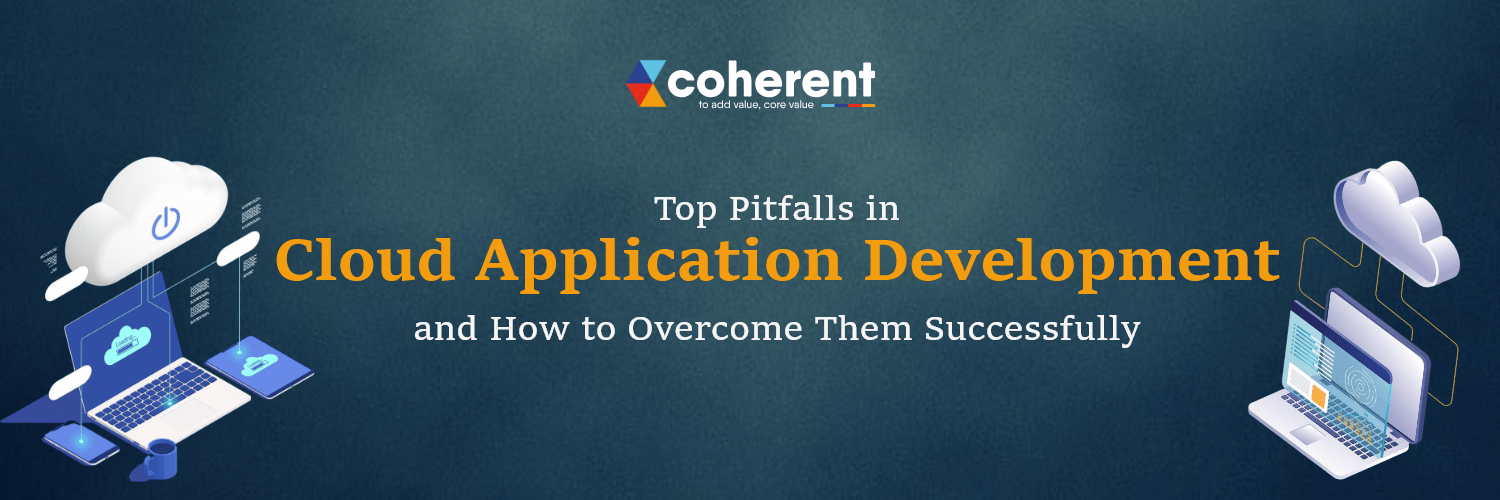Top Pitfalls in Cloud Application Development and How to Overcome Them Successfully

Cloud Right, Win Big! Cloud application development provides ease of access to data across devices through a single platform which has transformed organizations in the U.S. by enabling flexibility, remote work and cost-effective control of IT infrastructure. Did you know that Cloud applications have become so popular in the USA market it has become a requirement for individuals and organizations. However, cloud based app development does have its shortcomings; security vulnerabilities, connectivity concerns and technology limitations are still major concerns. With greater interdependence on cloud machine learning applications, identifying and overcoming these challenges is critical. So, be ready to explore in this blog post the most common pitfalls in cloud machine learning applications with solutions. Enhance your cloud projects today!
Cloud Application Development Meaning
Writing, creating and implementing applications based on cloud infrastructure is known as cloud application development. Cloud applications will take advantage of cloud services including storage, computation and networking to reach scalable, flexible and economical solutions too. Software Development in the cloud typically involves writing a new friendly front end using strong back-end systems and configuring delivery models such as public, private or hybrid cloud. Cloud based application development allows organizations to optimize performance, introduce a remote access capability and be agile when required.
Read More: Unlocking the Power of Open Source Cloud Applications: Benefits and Future Trends
Cloud-Based Applications Types
Cloud-based applications are categorized into different categories which can provide different outcomes in custom ways that fit different business styles. Below we provide some of the types:
Infrastructure as a Service
Infrastructure as a Service provides fundamental computing resources—such as servers, networking, storage and virtualization—which can be accessed through the cloud. IaaS takes the hardware question away from organizations and allows them to create the environment they want the way they want it. Developers should know how to develop cloud application concerned with middleware such as APIs and can build meaningful applications without having to deploy infrastructure.
Platform as a Service
Platform as a Service (PaaS), a cloud-based platform that exemplifies a complete solution from build to test to software application deployment. PaaS may include among other things, infrastructure, an operating system, middleware and development tools. Developers just write code – the platform takes care of back-end operations, scaling and running services. Join hands with our prominent cloud application development company to leverage PaaS solutions that enhance your app development and innovation.
Software as a Service
We can understand SaaS as Software as a Service which refers to fully functional software solutions that are hosted in the cloud and accessible online. No need for installation or maintenance and software as a service can be accessed from many devices. Ready to support your digital transformation, our expert cloud application development services assist you in creating tailored cloud solutions that seamlessly integrate with your software as a service applications, ensuring increased performance with scalability.
Cloud Application Development Pitfalls & How to Overcome Them
Cloud application development offers many benefits, but there are challenges as well. These challenges are not necessarily equal and a small mistake can destabilize a system on a lot of different operations. Below are the primary areas of concern U.S. developers and companies may experience with cloud infrastructure and services along with solutions that are proven effective for dealing with them:
Misleading Promises and Business Instability
Businesses in the United States choose cloud app development vendors simply based on price and functionality. However, inexpensive vendors may not have the financial resources or ecosystem of support needed for enterprise scale or other long-term considerations. These were important systems and data; if the vendor goes out of business, they may be lost, leading to loss of revenue and interruption to your operations.
How to overcome it?
Choose vendors with proven operational history and reliability, compliance specifications (most likely) and scale. Pick vendors that have an established footprint in the U.S. and can help with regional regulatory compliance and operate safely as you expand your organization.
Security Vulnerabilities
Security is still a concern for U.S. companies using cloud services. This includes any iOS app development company in USA as well. Staff often access cloud services through personal devices. Sometimes, they use public networks. This creates risks of data exposure. Weak or missing encryption can be a problem. Accidental sharing also increases the risk.
How to overcome it?
Depict enterprise-grade encryption, secured access (reverse proxies or VPNs) and stabilize it using U.S. standards (i.e., CISA guidelines, NIST). To reduce the possibility of unwanted access, implement and acquire updated cybersecurity software and require staff to participate in frequent security awareness training.
Ignoring Cost Management
Flexible pricing, when not monitored, can inspire over-provisioning and costs in U.S. cloud environments. Many organizations struggle with budget overruns from paying for underutilized resources, particularly if the over-provisioning happens across multi-cloud or hybrid environments.
How to overcome it?
Available in the United States, actively track usage with VMware CloudHealth or AWS Cost Explorer. Set budgets and alerting using cloud-native billing dashboards and avoid bringing under-utilized resources online. Compensate for the use of serverless and auto-scaling offerings while enforcing policies to shut down idle resources to cultivate cost discipline.
Lack of DevOps and Automation
Manual processes are slow and error-prone. U.S. companies shifting to responsive practices face scalability issues. Without DevOps and automation, problems get bigger as the company grows. Faster delivery requires consistent environments and workflows. This enables organizations to remain competitive and react swiftly to crises.
How to overcome?
CI/CD workflow methodology is used to describe your processes with tools like Jenkins, GitHub Actions and AWS CodePipeline. Automate infrastructure with Terraform or Azure Bicep to configure workflow and processes that include test, security and production deployments to consistently deliver value to the customer quickly.
Neglecting Data Strategy
Poor data management elevates risk across all U.S. cloud ecosystems, leading to performance problems, data sprawl and potential violations of compliance regulations like HIPAA or CCPA. If data is unstructured or you have poor management then you will rapidly increase costs and introduce a delay to the data.
How to overcome?
Select the proper storage category (data lake, relational database or object storage) for the app. Implement policy management on the data including compliance, retention and access. Utilize edge caching and CDNs for performance optimization and create a disaster recovery strategy.
Lack of Team Expertise and Training
A lot of U.S. teams do not have current cloud skill sets, leading to misconfigured services, suboptimal implementations and ultimately lost time. This large skill gap can derail innovation velocity, security approach and ROI from the cloud.
How to overcome it?
For businesses, you should promote cloud certification courses offered by Google Cloud, AWS or Azure. Also provide participation in labs doing hands-on work in sandbox environments. Utilize U.S. based consultants on complex projects to introduce new ways of doing things and encourage a DevSecOps mindset that boosts collaboration and continuous learning within roles.
Inadequate Testing Strategies
Testing, even in development or local environments, will not accurately assess the reality of operating in the U.S. cloud ecosystem. Interactions that are productive in local or test environments may not be the same once they are deployed into production. This is to say, problems may only be discovered after the new system is completely deployed into the U.S. government cloud. It can help lessen these risks by incorporating robust cloud testing practices and deployment strategies from the start if collaborating with an experienced android app development company in USA.
How to overcome it?
You need to conduct thorough testing in production-like staging environments to overcome this pitfall. Use disruption engineering tools like Gremlin to confirm stability. Use load testing scenarios, including JMeter or k6 and where possible, automate the load testing with CI/CD so issues are identified early.
Also Read: Cloud-Based App Development: Everything You Should Know
Wrapping up
Cloud Application Development is a huge promise, but with it come pitfalls that can destabilize even the most well-conceived efforts. For American businesses, the secret to avoiding unnecessary issues and realizing return on investment is knowing and purposefully avoiding these common pitfalls. Ready to succeed in developing cloud applications by avoiding pitfalls, never forget to collaborate with us. With deep expertise as a mobile app development company in USA , we'll help your company successfully traverse this path and make sure the cloud approaches are in line with goals for innovation and growth.
Frequently Asked Questions (FAQs)
Q1. What are the actual important challenges with a cloud-based application?
You faced challenges with cloud-based applications such as security exposures, data privacy issues, connection stability concerns and managing more complicated infrastructure. Without forward-thinking system management, scalability and performance tuning could also become issues. Like other issues we have covered they can all be alleviated with proper planning and security best practices and working with reputable vendors.
Q2. How can I secure my cloud-based app?
There are a few different ways to secure your cloud-based application by using access controls, encrypting your data both in transit and at rest, applying updates and keeping an eye out for thorough audit log information for abnormal or unusual activities. Deploy multi factor authentication and employ secure APIs to assist in protecting your cloud environment.
Q3. What is vendor lock-in and what actual strategies can I use to prevent it?
Customers who become dependent on a vendor's goods or services and are unable to move to another vendor without paying an expensive price are said to be experiencing vendor lock-in. To prevent vendor lock-in, customers should adopt open standards and modular architectures, enabling easier data migration between vendors within a defined scope and reducing switching costs thereby avoiding dependence on a single provider.
Q4. How do I actually choose the best cloud provider?
Scalability, security, compliance and price, with the help of these points, you can choose the best cloud provider. Review service features, reliability, support choices and global presence. Customer sentiment and awareness of SLAs should also be taken into account. Trial or pilot runs can prove real-time performance and confirm compatibility before final selection.
Q5. Is cloud development more economical than traditional approaches?
Yes, cloud development usually means lower costs since you avoid investing in large amounts of processing power. You get scalability, lower maintenance costs and deployment speed, but you need to be careful to avoid unexpected costs by not managing resources properly. Overall cloud development can provide cost savings and particularly so for organizations that are dynamic and growing too.


 +91 774-202-1725
+91 774-202-1725
 +1 (945) 3387904
+1 (945) 3387904
 business@coherentlab.com
business@coherentlab.com +49 15223341304
+49 15223341304 UK
UK

